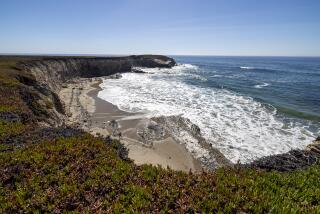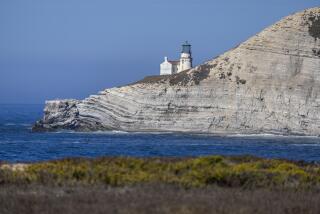Channel Islands Park Officials Propose Environmental Center : Education: The facility would instruct students and other visitors about marine life, Indian heritage and history. But it is uncertain how it would be funded.
- Share via
Channel Islands National Park officials want to build an environmental education center in Ventura or Oxnard that could draw thousands of schoolchildren and visitors annually--but they are not sure how to pay for it.
Under the ambitious plan, park officials say they would need to come up with between $3 million and $10 million to build a center that would instruct students about marine life, Chumash Indian heritage and the history of the Channel Islands.
“Right now, environmental education at the Channel Islands Visitor Center consists of busloads of school kids coming and sitting on concrete and getting a 20- to 30-minute talk from one of our staffers,” said Tim Setnicka, chief of the park’s operations.
Park Supt. C. Mack Shaver estimated that the proposed center would be 15,000 to 20,000 square feet, and be ready in three years at the earliest. He said park officials are considering sites at Ventura Harbor and Channel Islands Harbor.
Funding for the center is still “up in the air,” Shaver said. He plans to have it built by a private developer, who would then lease it to the federal government.
Shaver said he has a better chance of getting the money for a yearly lease compared to a lump sum upfront of $10 million. He estimated that leasing the building would cost about $500,000 annually, and he is optimistic that he will be able get federal funding for the lease.
Aides to Rep. Elton Gallegly (R-Simi Valley) have expressed interest in the proposal, and Shaver said he also expects to get funding from local government agencies that will be involved in the project, including school districts and the county.
“It isn’t really a pipe dream because the political climate is right for this,” Shaver said.
About 25 marine biologists and teachers were invited by park officials this week to come up with ideas about what should be in the proposed center.
The group envisioned a two-story circular building that would house laboratory rooms, auditoriums and exhibits that would teach children and other visitors about the kelp forest, tide pools, marine life, physical oceanography and Chumash Indian heritage.
*
Park officials say the visitor center at Ventura Harbor is not equipped or large enough to put together an environmental education program envisioned for students from kindergarten through 12th grade.
“The visitor center serves the entire spectrum of the population,” national park spokeswoman Carol Spears said. “It has general information about how to get to the park, and some education programs, but is primarily geared toward adults.”
The proposed environmental center would especially attract schoolchildren, and park officials would work closely with teachers so that programs would be part of their curricula, Spears said.
“It will be very sensory,” Spears said. “It’s not going to be, ‘Look at that picture, and read the text.’ There is nothing like this south of Monterey Bay and north of Scripps Institute.”
Shaver said the proposed center would also help generate more interest in Channel Islands National Park, which has fewer visitors than any national park in California, except for Devil’s Postpile near Mammoth Lakes.
“We can stand more visitation,” Shaver said.
Last year, an estimated 55,500 visitors went to the islands. About 166,800 people stopped at the visitor center last year and then went home without ever reaching the five-island chain.
Officials estimate that the environmental center would attract up to 300,000 visitors and create more interest in venturing out to the islands. Eventually, park officials want to build an auxiliary center on one of the islands, Shaver said.
*
Elaine Daugherty, an Oxnard junior high school science teacher, said the center would help supplement her classroom lessons.
“It’s a lot more interesting to actually look at the plants or animals than watching it on a video or reading about it in a textbook,” she said. “I’m really excited about it.”
More to Read
Sign up for Essential California
The most important California stories and recommendations in your inbox every morning.
You may occasionally receive promotional content from the Los Angeles Times.













